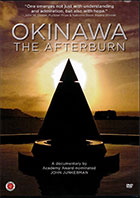
Okinawa: The Afterburn 2016
Distributed by First Run Features, 630 Ninth Avenue, Suite 1213, New York, NY 10036; 212-243-0600
Produced by Yamagami Tetsujiro
Directed by John Junkerman
DVD, color, 121 min.
High School - General Adult
History, International Relations, Political Rights, War, Activism, Area Studies, Asians, Civil Rights, Crimes Against Humanity, Current Events, International Relations, Government, Human Rights, Native Peoples, World War II, Okinawa
Date Entered: 03/15/2017
Reviewed by Joseph Baumstarck, Jr., University of Louisville, Southern Baptist Theological Seminary, Ivy Tech Community CollegeOkinawa, The Afterburn, is a four-part film which depicts a history, culture, people, and events which most Americans know little about. Although Okinawans have spent over seventy years protesting an occupation of their island home by the American military most Americans are not even aware that problems exist, or the extent to which Okinawa is still occupied. Okinawans join a chorus of native people protesting American and western occupation through military presence in their countries. What sets Okinawan protests apart is the volume, justice, and tenacity of these protests.
The film does a good job of representing the protestors point of view and a mediocre job of presenting the countering point of view. The director is clearly on the side of the protestors, but still allows voices from the opposing side to be heard. The juxtaposition of the two sides is significant enough to develop some of the tension throughout the film. Multiple locations and scenes show both sides involved in activist activities and even show protestors placing ribbons and tape to deface airfield fences and supporters removing them.
In Part 1, an account of the Battle of Okinawa using rare historical colored footage and excellent historical analysis sets the stage for the rest of film. Survivors of the battle are interviewed from the American, Okinawan, and Japanese sides. Although elderly the interviewees are clear and precise about the events they witnessed. Beginning on April 1, 1945, and ending on June 30, 1945, the battle left Okinawa devastated and the Americans in control of an island near Japan from which to launch airstrikes and build up huge military bases and airfields. Survivors recount heart-wrenching atrocities from all sides, with most of the atrocities surrounding the invasion attributed to the Americans and some attributed to the Japanese during its prior occupation of Okinawa. The terror and danger which afflicted the Okinawans during the battle, that is not included in most histories of World War II, is clearly delineated through the voices of the survivors.
Part 2, covers the American occupation from the end of the battle through the 1950s and the 1960s. Despite assurances that Okinawa would be returned to the Okinawan people and that self-government would be reinstated quickly these promises were not kept. Realizing the significance of Okinawa as a forward Asian base during the Cold War the United States occupation of significant portions of the island continued and additional area came under American control during this period when nuclear weapons and bases to house them were added to the many airfields and other military bases that were already there. Despite the intent of many Okinawan people to establish a non-military nation the buildup of American military power continued. During the 1960s the possibility of reversion to Japan became a rallying point for many of the activists who wanted to see American bases removed from the island. Although it took until 1972 this dream was accomplished only to be shattered by the government officials of Japan who continued to allow the American bases to remain. The Okinawan feelings of disappointment and anger at the betrayal by Japan are well documented in the film.
Part 3 explores numerous violations that have occurred to the Okinawan people, mostly women, at the hands of American military personnel. Witnesses from both sides tell their stories and clearly demonstrate that these violations frequently occur. It is also clear that they are the result of the presence of the military bases and the unequal political powers granted to them. Although there is some attempt to argue that the Okinawan economy gains from these bases the overall impact to Okinawa is negative and only ten percent of the total Okinawan economy is derived from American bases. In most cases the bases are self-contained communities with their own laws and governance set up to ensure the continuation of a lopsided relationship.
Part four, despite the numerous problems presented in the first three parts, develops an optimistic view that change can be accomplished and that Okinawans are ever hopeful for this to occur. Throughout the film a burgeoning Okinawa does shine through with obvious non-military development into a modern cityscape of prosperous businesses and the accompanying bustle and clutter. The natural beauty of the island and the Okinawan peoples’ resilience and optimism leaves the viewer with a feeling of hope after the atrocities depicted.
Overall this is a very well done film with a clear storyline told by believable people who experienced many of the things they are discussing. It is clear that the majority of the Okinawan people want the removal of the military bases and the return of the island to themselves. It is also clear that Okinawa would be able to support itself as an independently governed nation and that the military bases, although possibly beneficial to the United States, are a definite detriment to Okinawa. The film has no real negatives and significant positives. It also documents a situation which is rarely presented to American audiences. For these reason a rating of highly recommended is given.